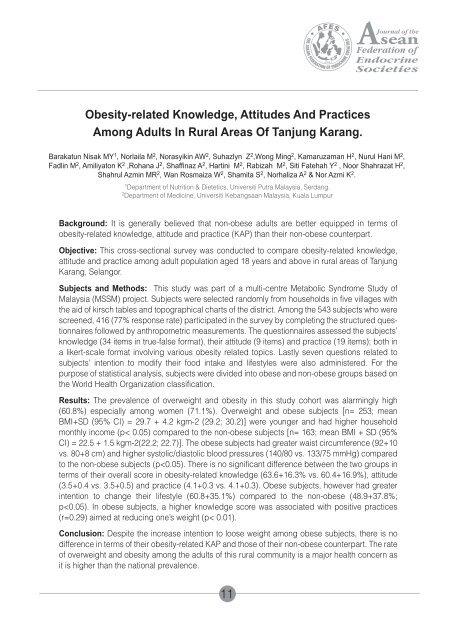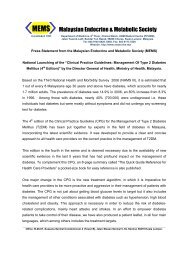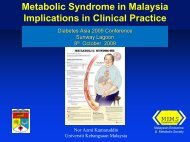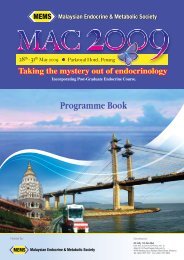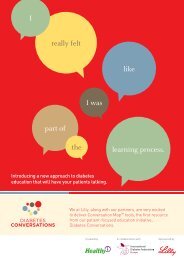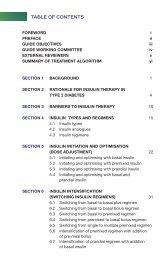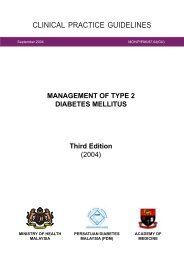JAFES-Booklet (English - pdf - 1103 Kb) - MEMS
JAFES-Booklet (English - pdf - 1103 Kb) - MEMS
JAFES-Booklet (English - pdf - 1103 Kb) - MEMS
You also want an ePaper? Increase the reach of your titles
YUMPU automatically turns print PDFs into web optimized ePapers that Google loves.
Obesity-related Knowledge, Attitudes And Practices<br />
Among Adults In Rural Areas Of Tanjung Karang.<br />
Barakatun Nisak MY 1 , Norlaila M 2 , Norasyikin AW 2 , Suhazlyn Z 2 ,Wong Ming 2 , Kamaruzaman H 2 , Nurul Hani M 2 ,<br />
Fadlin M 2 , Amiliyaton K 2 ,Rohana J 2 , Shaffinaz A 2 , Hartini M 2 , Rabizah M 2 , Siti Fatehah Y 2 , Noor Shahrazat H 2 ,<br />
Shahrul Azmin MR 2 , Wan Rosmaiza W 2 , Shamita S 2 , Norhaliza A 2 & Nor Azmi K 2 .<br />
1 Department of Nutrition & Dietetics, Universiti Putra Malaysia, Serdang.<br />
2 Department of Medicine, Universiti Kebangsaan Malaysia, Kuala Lumpur<br />
Background: It is generally believed that non-obese adults are better equipped in terms of<br />
obesity-related knowledge, attitude and practice (KAP) than their non-obese counterpart.<br />
Objective: This cross-sectional survey was conducted to compare obesity-related knowledge,<br />
attitude and practice among adult population aged 18 years and above in rural areas of Tanjung<br />
Karang, Selangor.<br />
Subjects and Methods: This study was part of a multi-centre Metabolic Syndrome Study of<br />
Malaysia (MSSM) project. Subjects were selected randomly from households in five villages with<br />
the aid of kirsch tables and topographical charts of the district. Among the 543 subjects who were<br />
screened, 416 (77% response rate) participated in the survey by completing the structured questionnaires<br />
followed by anthropometric measurements. The questionnaires assessed the subjects’<br />
knowledge (34 items in true-false format), their attitude (9 items) and practice (19 items); both in<br />
a likert-scale format involving various obesity related topics. Lastly seven questions related to<br />
subjects’ intention to modify their food intake and lifestyles were also administered. For the<br />
purpose of statistical analysis, subjects were divided into obese and non-obese groups based on<br />
the World Health Organization classification.<br />
Results: The prevalence of overweight and obesity in this study cohort was alarmingly high<br />
(60.8%) especially among women (71.1%). Overweight and obese subjects [n= 253; mean<br />
BMI+SD (95% CI) = 29.7 + 4.2 kgm-2 (29.2; 30.2)] were younger and had higher household<br />
monthly income (p< 0.05) compared to the non-obese subjects [n= 163; mean BMI + SD (95%<br />
CI) = 22.5 + 1.5 kgm-2(22.2; 22.7)]. The obese subjects had greater waist circumference (92+10<br />
vs. 80+8 cm) and higher systolic/diastolic blood pressures (140/80 vs. 133/75 mmHg) compared<br />
to the non-obese subjects (p


